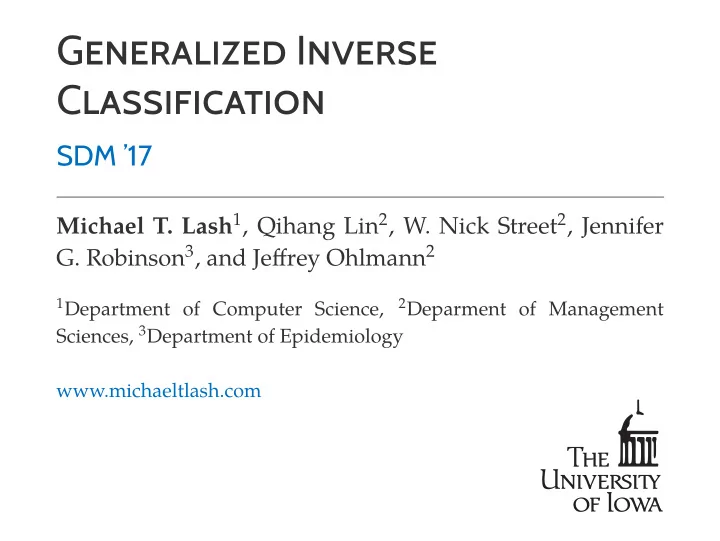

GENERALIZED INVERSE CLASSIFICATION SDM ’17 Michael T. Lash 1 , Qihang Lin 2 , W. Nick Street 2 , Jennifer G. Robinson 3 , and Jeffrey Ohlmann 2 1 Department of Computer Science, 2 Deparment of Management Sciences, 3 Department of Epidemiology www.michaeltlash.com
What is inverse classification ? � The process of making meaningful perturbations to a test instance such that the probability of a desirable outcome is maximized. 1
What is inverse classification ? � The process of making meaningful perturbations to a test instance such that the probability of a desirable outcome is maximized. 1
What is inverse classification ? � The process of making meaningful perturbations to a test instance such that the probability of a desirable outcome is maximized. 1
What is inverse classification ? � The process of making meaningful perturbations to a test instance such that the probability of a desirable outcome is maximized. 1
What is inverse classification ? � The process of making meaningful perturbations to a test instance such that the probability of a desirable outcome is maximized. 1
What is inverse classification ? � The process of making meaningful perturbations to a test instance such that the probability of a desirable outcome is maximized. 1
What is inverse classification ? � The process of making meaningful perturbations to a test instance such that the probability of a desirable outcome is maximized. 1
What is inverse classification ? � The process of making meaningful perturbations to a test instance such that the probability of a desirable outcome is maximized. What about the meaningful part of the definition? 1
M eaningful Perturbations Well...lets visit some past work! � Michael T. Lash, Qihang Lin, W. Nick Street, and Jennifer G. Robinson, “A budget-constrained inverse classification framework for smooth classifiers”, arXiv preprint arXiv:1605.09068 , submitted. 2
M eaningful Perturbations Begin with a basic formulation. 2
M eaningful Perturbations 2
M eaningful Perturbations 2
M eaningful Perturbations Some regressor Segment features. 2
M eaningful Perturbations Some regressor Estimate indirectly changeable. 2
M eaningful Perturbations Some regressor Update objective function. Add constraints. 2
M eaningful Perturbations Some regressor Cost-change function 2
M eaningful Perturbations Budget Some regressor 2
M eaningful Perturbations Bounds Some regressor 2
M ain Contributions 1. Relax assumptions about f ( · ) . Bounds Some regressor 3
M ain Contributions 1. Relax assumptions about f ( · ) . Bounds Some regressor 3
M ain Contributions 1. Relax assumptions about f ( · ) . Bounds Some regressor Generalized inverse classification 3
M ain Contributions 1. Relax assumptions about f ( · ) . 2. Quadratic cost-change function. Some regressor 4
M ain Contributions 1. Relax assumptions about f ( · ) . 2. Quadratic cost-change function. Some regressor 4
M ain Contributions 1. Relax assumptions about f ( · ) . 2. Quadratic cost-change function. Some regressor 4
M ain Contributions 1. Relax assumptions about f ( · ) . 2. Quadratic cost-change function. 3. Three real-valued heuristic optimization methods and two sensitivity analysis-based optimization methods. * Projection operator to maintain feasibility. 5
Op timization Methodology Heuristic � Hill Climbing + Local Search (HC+LS) � Genetic Algorithm (GA) � Genetic Algorithm + Local Search (GA+LS) Sensitivity Analysis � Local Variable Perturbation – First Improvement (LVP-FI) � Local Variable Perturbation – Best Improvement (LVP-BI) 6
Experiment Decisions and Data � f ( · ) : Random forest � H ( · ) : Kernel regression � Dataset 1: Student Performance (UCI Machine Learning Repository). � Dataset 2: ARIC � One f for optimization, separate f for heldout evaluation. 7
R esults: Student Performance 8
R esults: Student Performance 8
R esults: ARIC 9
R esults: ARIC Need sparsity constraints 9
C onclusions � Generalized Inverse Classification: can use virtually any learned f (as shown by experiments w/ Random Forest classifier). � Our proposed methods were successful, although this varied by dataset. 10
GENERALIZED INVERSE CLASSIFICATION SDM ’17 Michael T. Lash 1 , Qihang Lin 2 , W. Nick Street 2 , Jennifer G. Robinson 3 , and Jeffrey Ohlmann 2 1 Department of Computer Science, 2 Deparment of Management Sciences, 3 Department of Epidemiology www.michaeltlash.com 10
Causality and Inverse Classification 11
Causality and Inverse Classification � Yes! .... 11
Causality and Inverse Classification � Yes! .... � What we’re doing: 1. Imposing our own causal structure (DAG). 2. We’re not taking the usual counterfactual approach. 11
Causality and Inverse Classification � Yes! .... � What we’re doing: 1. Imposing our own causal structure (DAG). 2. We’re not taking the usual counterfactual approach. � Future work will focus on incorporating causal methodology... 11
Recommend
More recommend